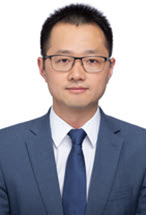Guian Qian

Dr., Full Professor in the state key laboratory of nonlinear mechanics, Chinese Academy of Sciences, Beijing, China.
ResearchGate: LINK
Google Scholar: LINK
CAREER SUMMARY
Full Professor in the state key laboratory of nonlinear mechanics, Chinese Academy of Sciences, China, focusing on solid mechanics, applied mechanics, including fatigue and fracture assessments of engineering components.
WORKING EXPERIENCE
• 2018.5-present, awarded Hundred Talent Program of Chinese Academy of Sciences, the state key laboratory of nonlinear mechanics, Chinese Academy of Sciences, China
• 2013.1-2018.3, Scientist in the Laboratory for nuclear materials, Nuclear energy and safety department, Paul Scherrer Institute, Switzerland
Perform integrity analyses for reactor pressure vessels and piping considering ageing mechanisms, providing lifetime prediction for long term operation of nuclear power plants
• 2009.8-2012.12, Postdoctoral fellow in the Laboratory for nuclear materials, Nuclear energy and
safety department, Paul Scherrer Institute, Switzerland
Conducted probabilistic analysis for reactor pressure vessels subjected to pressurized thermal shock
EDUCATION
• 2005.9- 2009.7 Institute of Mechanics, Chinese Academy of Sciences, China
Ph.D. in Solid Mechanics
SCIENTIFIC SERVICES
• Session Developer & Chair for ASME Pressure Vessels & Piping Conference (PVP), 2015-2018, Asian programs in structural integrity, 14th International Conference on Fracture June 18-23, 2017, Analysis and Testing of Fracture under Multi•axial/Biaxial Loading Conditions
• Subject Editor for Material Design and Processing Communication
• Journal Guest Editor for International Journal of Fatigue, Theoretical and Applied Fracture Mechanics, Advances in Mechanical Engineering, Energies
• Journal Editor for Journal of Mechanics Engineering and Automation
• Journal Outstanding Reviewer for Fatigue & Fracture of Engineering Materials & Structures, Annals of Nuclear Energy, Nuclear Inst. And Methods in Physics Research
• Funding Reviewer for Slovak Research and Development Agency
• Journal Reviewer for Mechanics of Materials, Theoretical and Applied Fracture Mechanics, Corrosion Science, Engineering Fracture Mechanics, Computation Materials Science, International Journal of Fatigue, Nuclear Engineering and Design, Fatigue & Fracture of Engineering Materials & Structures, International Journal of Nuclear Energy, Steel Research International, Engineering Failure Analysis, Nuclear Engineering and Technology, ASME Journal of pressure vessel technology, Engineering Structures, Ocean Engineering, International journal of Mechanical Sciences, International Journal of Electrical Power and Energy Systems, Arabian Journal for Science and Engineering, The Journal of Strain Analysis for Engineering Design
KEYNOTE PRESENTATIONS
• Application of weakest link concept to fatigue and fracture assessment. IRAS 2019, First International Symposium on Risk Analysis and Safety of Complex Structures and Components.1-2 July 2019, Porto, Portugal (plenary speaker).
• Review of Integrity analyses of the Reactor Pressure Vessels in Taiwan and Switzerland (PSI). 11th International Workshop on the Integrity of Nuclear Components, April 11-13, 2016, Nagasaki, Japan
• Methodology and warm prestressing effect for pressurized thermal shock analysis in nuclear power plant. International Symposium on Structural Integrity August 20-24, 2014, Lanzhou, China
• Key issues in the integrity assessment of nuclear pressure vessel. Chinese Materials Conference 2017 (CMC 2017), Symposium Nuclear Materials. July 6-12, Yinchuan, China
• Crack propagation mechanism and life prediction for very-high-cycle fatigue of a structural steel in different environmental medias. 2nd IJFatigue & FFEMS joint conference: characterization of crack tip stress fields (invited keynote speaker). Malaga, Spain, 2013, April 15-17.
HONORS
• 2018 Hundred Talent Program of Chinese Academy of Sciences
• 2018 European Structural Integrity Society young scientist award first prize
• 2016, ASME PVP (Pressure Vessels & Piping Conference) Outstanding Technical Paper
• 2013, 2016, 2017 Excellent employee award at PSI, Switzerland
• 2019 highly cited paper in European Journal of Mechanics, Philosophical Magazine
• 2016 highly cited paper in Nuclear Engineering Design
RESEARCH EXPERIENCE
Probabilistic fracture mechanics analyses for reactor pressure vessels and nuclear piping, 2009- present
• A procedure and software are developed to perform probabilistic analysis for reactor pressure vessels subjected to pressurized thermal shocks by considering material irradiation embrittlement, crack distribution and thermal stresses. Abaqus, FAVOR, VISA-II and PASCAL codes are modified to perform fracture mechanics and probabilistic analyses, providing guidance for the lifetime extension of a nuclear power plant.
• A method for the transferability of toughness from small specimens to the reactor pressure vessel is proposed. Warm prestressing effect on the integrity of reactor pressure vessels is quantified by the micromechanical models.
• Statistical analysis of fracture toughness is performed by Master Curve and ASME methods.
Sensitivity analysis is conducted to investigate the important random variables on the failure frequency of a reactor pressure vessel.
• Leak-before-Break analysis of nuclear piping is performed considering fatigue and stress corrosion cracking mechanisms.
Cleavage brittle fracture for nuclear materials, 2012-present
• A new statistical model is developed and calibrated to overcome the limitation of the traditional models. A method to calibrate the parameters of a local approach model is proposed based on Master Curve method.
• The lower bound of the fracture toughness in the ductile-to-brittle transition region is predicted. The fracture probability at different crack driving force is modelled.
Probabilistic failure analysis of piping system according to FITNET FFS, 2009-present
• Probabilistic corrosion and fracture analyses for piping are conducted based on FITNET FFS, a European procedure for structural integrity analysis.
• A computer code is developed by considering the correlated random variables. The effect of correlation coefficient of the involved variables, as well as the number of cracks on the failure probability of the piping is quantified.
Crack initiation and propagation in very-high-cycle fatigue, 2006-2009
• The Very-High-Cycle fatigue (VHCF) property of structural steel in air and environmental media (water and 3.5% NaCl solution) is comprehensively studied. The mechanism of VHCF and a corresponding model are developed.
• S-N curves in different environmental media are obtained. VHCF behavior challenges traditional fatigue limit, providing a new design criterion for engineering structures in VHCF.
• A model based on dislocation deformation is proposed to account for the mechanism of fatigue initiation site transition in high cycle and VHCF regimes. The model agrees well with the experimental observations.







